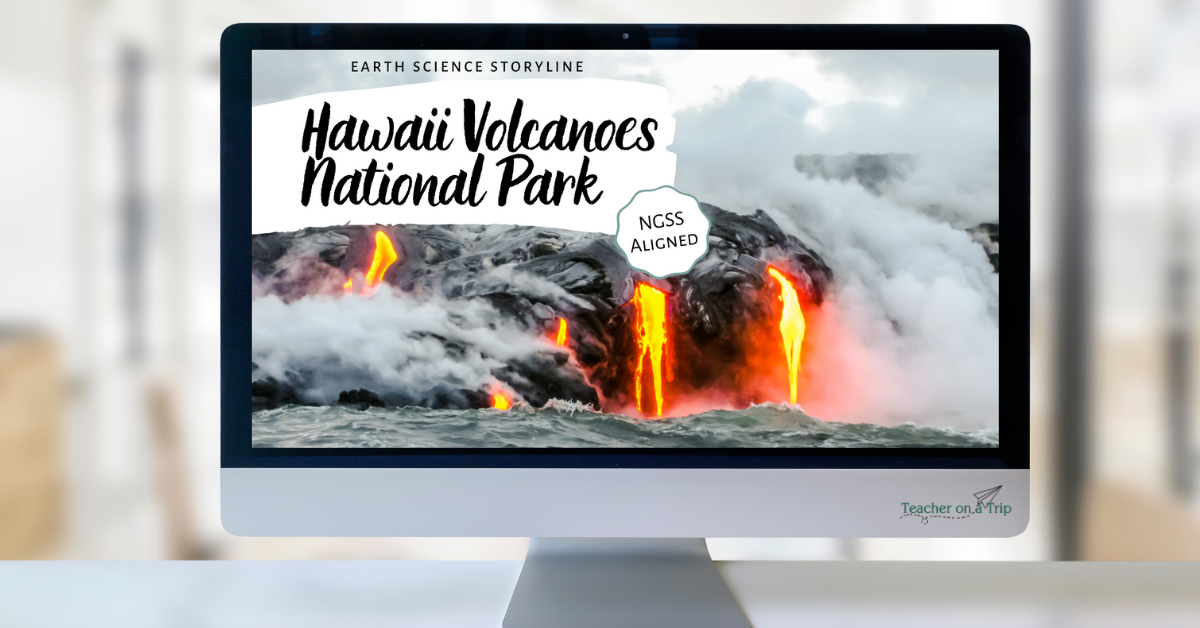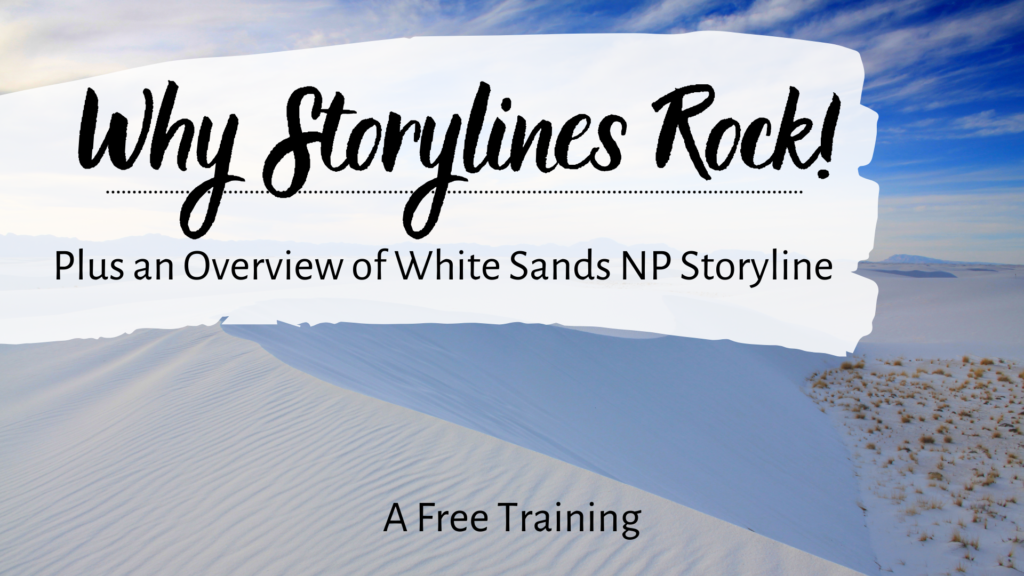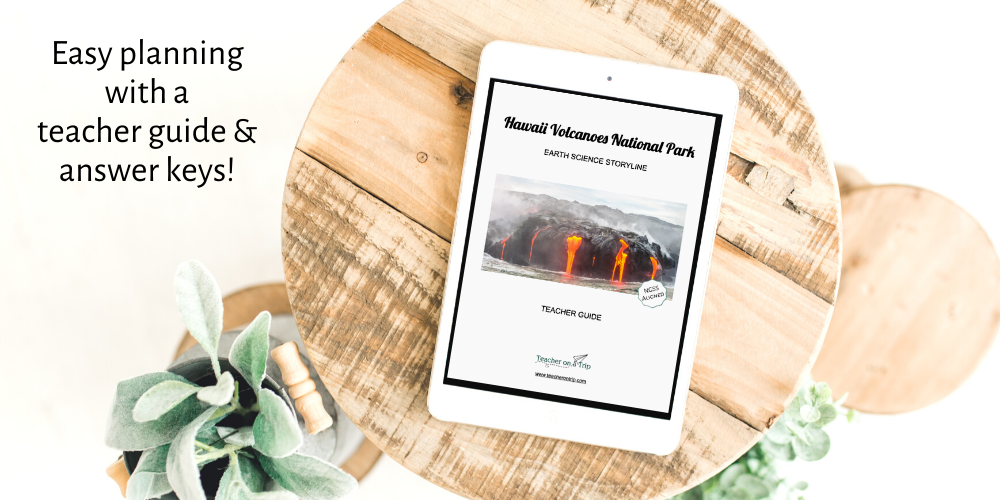NGSS Earth Science Storyline: Hawaii Volcanoes NP

What is a Storyline?
An NGSS Earth science storyline is an intentionally sequenced series of lessons that begins with a phenomenon, encourages student investigations to discover findings, and assesses student learning in three dimensions.
Yes, three dimensions! In an NGSS aligned classroom, students are learning more than just content. So, what are these three dimensions?
- Dimension 1: Science & Engineering Practices – What students are doing
- Dimension 2: Crosscutting Concepts – How students are thinking and making connections
- Dimension 3: Disciplinary Core Ideas – What students are learning
You can take a real deep dive into reading more about and the origin of the 3-Dimensions in the Framework of K-12 Science Education.

Why use NGSS Earth Science Storylines?
NGSS storylines are less “teaching as telling” and more student-led discovery. The teacher becomes the facilitator and students take on more responsibility for their own learning. This is not a teaching fad that will come and go faster than fashion styles change. This is a real-deal transformation in how we teach and how our students learn.
Students’ confidence in their science abilities grow as they learn more through doing science. That’s the NGSS difference. If you’re new to NGSS and using storylines, check out this FREE training – Why Storylines Rock! | Plus an Overview of White Sands NP Storyline. You’ll get an in-depth explanation storylines along with a sneak peek of the first NGSS Earth science storyline used with my students.

Performance Expectations
The following performance expectations are covered in Hawaii Volcanoes NP Storyline.
HS-ESS1-5: Evaluate evidence of the past and current movements of continental and oceanic crust and the theory of plate tectonics to explain the age of crustal rocks.
HS-ESS2-1: Develop a model to illustrate how Earth’s internal and surface processes operate at different spatial and temporal scales to form continental and ocean-floor features.
HS-ESS2-3: Develop a model based on evidence of Earth’s interior to describe the cycling of matter by thermal convection.
HS-ESS3-1: Construct an explanation based on evidence for how the availability of natural resources, occurrence of natural hazards, and changes in climate have influenced human activity.
Disciplinary Core Ideas – What Students Learn
The following Disciplinary Core Ideas are covered in Hawaii Volcanoes NP Storyline. Descriptions are from the Next Gen Science Standards App.
ESS1.C: The History of Planet Earth
- Continental rocks, which can be older than 4 billion years, are generally much older than the rocks on the ocean floor, which are less than 200 million years old.
ESS2.A: Earth Materials and Systems
- Earth’s systems, being dynamic and interacting, cause feedback effects that can increase or decrease the original changes.
ESS2.B: Plate Tectonics and Large-Scale System Interactions
- Plate tectonics is the unifying theory that explains the past and current movements of the rocks at Earth’s surface and provides a framework for understanding its geologic history.
- Plate movements are responsible for most continental and ocean-floor features and for the distribution of most rocks and minerals within Earth’s crust.
ESS3.A: Natural Resources
- Resource availability has guided the development of human society.
ESS3.B: Natural Hazards
- Natural hazards and other geologic events have shaped the course of human history; [they] have significantly altered the sizes of human populations and have driven human migrations.
PS4.A: Wave Properties
- Geologists use seismic wave and their reflection at interfaces between layers to probe structures deep in the planet.
Science & Engineering Practices – What Students Do
The following Science & Engineering Practices are incorporated in the Hawaii Volcanoes NP Storyline. Descriptions are from the Next Gen Science Standards App.
Developing and Using Models
- Develop a model based on evidence to illustrate the relationships between systems or between components of a system.
Engage in Argument From Evidence
- Evaluate evidence behind currently accepted explanations or solutions to determine the merits of arguments.
Constructing Explanations and Designing Solutions
- Construct an explanation based on valid and reliable evidence obtained from a variety of sources (including students own investigations, models, theories, simulations, peer review) and the assumption that theories and laws that describe the natural world operate today as they did in the past and will continue to do so in the future.
The above science & engineering practices are emphasized throughout the storyline, however additional science & engineering practices are also included.
Crosscutting Concepts – How Students Think & Process
The following Crosscutting Concepts are incorporated in the Hawaii Volcanoes NP Storyline. Descriptions are from the Next Gen Science Standards App.
Patterns
- Empirical evidence is needed to identify patterns
Stability and Change
- Change and rates of change can be quantified and modeled over very short or very long periods of time. Some system changes are irreversible
Energy and Matter
- Energy drives the cycling of matter within and between systems
Cause and Effect
- Empirical evidence is required to differentiate between cause and correlation and make claims about specific causes and effects.
The above crosscutting concepts are emphasized throughout the storyline, however additional crosscutting concepts are also included.
Phenomenon
Storylines begin with phenomenon. This provides an equitable starting experience for all students and an opportunity for students to ask questions that we will investigate throughout the storyline.
Hawaii Volcanoes NP Storyline starts with this time lapse video of the 2018 Kilauea eruption.
Activities in Hawaii Volcanoes NP NGSS Earth Science Storyline
Examples of activities:
- Develop driving questions based on phenomenon
- Observe and analyze rock samples to determine likely mineral composition
- Compare intrusive and extrusive igneous rocks and the processes that form them
- Interpret maps of active and extinct volcanoes to determine motion of Pacific Plate
- Identify patterns of geological features caused by plate motion
- Predict direction of plate movement based on geological features observed
- Model plate boundaries with common classroom/household items
- Compare volcanic eruptions and type of magma
- Design a model to represent convection currents
- Determine Earth Layers based on density and seismic wave data
- Analyze radioactive isotope decay in the mantle
- Construct explanations for why humans live in areas where natural disasters occur and how lives have been impacted over history
Assessment in Hawaii Volcanoes NP NGSS Earth Science Storyline
Students are learning differently in a NGSS aligned classroom, so how we assess them will look a little different as well. The assessment is more than a recall of information memorized during the unit. Students are assessed in all 3 dimensions, therefore they will need to apply their science practices and thinking skills utilized during the storyline.
Yes, students will be evaluated over what they learned. But, they will also be assessed over their understanding of processes by developing models, engaging in argument from evidence, and constructing explanations for novel phenomenon.
In the Hawaii Volcanoes NP Storyline, students are introduced to hydrothermal vents that occur at plate boundaries, a hotspot under Yellowstone, divergent boundary at Iceland, and more! Although the specific phenomena is new to students, they have the understandings and skills to determine what is occurring and why.
What’s Included with Hawaii Volcanoes NP NGSS Earth Science Storyline?
When you purchase Hawaii Volcanoes NP Storyline and add a motivated teacher, you’ll have everything you need!

Here’s what’s included:
- Thorough Teacher Guide with daily lessons
- Printable in-person student worksheets
- In-person supplement slides via Google SlidesTM
- Digital student slides via Google SlidesTM (use instead of worksheets!)
- Lab activities
- Materials list for each lesson
- Answer keys for in-person student worksheets & assessments
- Hawaii Volcanoes National Park Digital Field Notebook via Google SlidesTM